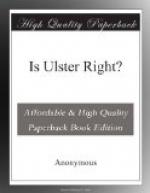Soon afterwards, Mr. Justice Ross, who, as Judge of the Land Judge’s Court, Chancery Division, was in charge of many estates in Ireland, said:
“He had known from other Receivers about this widespread and audacious conspiracy at present rampant in the West of Ireland ... This was actually a conspiracy which on ordinary moral grounds amounted to highway robbery, to seize on these grass lands, to drive away the stock of the people who had been in the habit of taking it; and then, when the owner had been starved out, the Estates Commissioners were expected to buy up the property and to distribute it amongst the very people who had been urging on the business, and who had been engaged in these outrages.”
When an Ulster member drew attention to this in the House of Commons, Mr. Birrell replied:—
“There is no evidence
before the Government that a widespread
conspiracy is rampant in the
West of Ireland.”
And in reply to another question he said that:—
“The reports he received
from the police and other persons
revealed the condition of
Ireland generally as to peace and
order as being very satisfactory.”
During the month of October 1907, twenty-nine claims for compensation from the rates in respect of malicious injuries had been proved and granted in twelve counties, the amount levied from the ratepayers being about L900. The malicious injuries comprised destruction of and firing into dwelling houses, mutilation of horses and cattle, burning cattle to death, spiking meadows and damaging mowing machines, damages to fences and walls, burning heather and pasturage, damage to gates in connection with cattle driving, and injury to cattle by driving. And in November an attempt was made to assassinate Mr. White Blake and his mother when driving home from church in the County Galway. A few days after this occurred Mr. Redmond said at a meeting in North Wales:—
“Whilst there is no crime or outrage there is widespread unrest and impatience, and there are, over a certain section of the country, taking place technical breaches of the strict letter of the law in the shape of what is called cattle driving. Now let me say first of all that in no instance has any single beast been injured in the smallest degree in any of these cattle-drives; in no instance has any malicious injury been done to property, life or limb, or beast.”
All this time the Government adhered to their determination not to put the Crimes Act in force, but merely to place accused persons on trial before juries at the Assizes. The results were as follows: At the Summer Assizes in 1907, 167 persons were returned for trial; of these, 57 were actually tried, of whom three were convicted, 31 acquitted, and in 23 cases the juries disagreed. The trials of the remaining 110 were postponed. At the Michaelmas sittings, 94 persons were put on trial, of whom 5 were convicted and 2 acquitted; in 72 cases the juries disagreed, and in the remaining 15 the Crown abandoned proceedings. At the Winter Assizes 86 persons were tried for unlawful assembly, riot and conspiracy in connection with cattle-driving. None were convicted; 11 were acquitted; in 12 cases the prisoners were discharged on legal points; and in 63 the juries disagreed.




